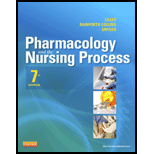
To review:
The functions of the sympathetic nervous system and the specific effects of adrenergic-blocking drugs.
Introduction:
The central nervous system (CNS) and peripheral nervous system (PNS) are considered as the two important branches of the nervous system. The CNS consists of the spinal cord and brain, whereas the PNS contains autonomic (ANS) and somatic nervous system (SNS). The ANS is further divided into the sympathetic or adrenergic and parasympathetic or cholinergic.
Explanation of Solution
Functions of the sympathetic nervous system:
Adrenergic compounds are involved in the therapeutic effects with the help of their receptors. They stimulate the SNS and it is known as adrenergic agonists. They are also known as sympathomimetic because they mimic the SNS neurotransmitters effects such as norepinephrine, dopamine, and epinephrine. These neurotransmitters are classified in terms of chemical nature as catecholamines. The G-protein coupled adrenergic receptors targets the catecholamines neurotransmitters such as epinephrine (adrenaline) and norepinephrine (noradrenaline). These adrenergic receptors of the SNS provide the check and balance system to maintain the body homeostasis.
Specific effects of adrenergic-blocking drugs:
The adrenergic-blocking drugs cause the opposite effects with the adrenergic agonist drugs. They block the stimulation of sympathetic nervous system neurotransmitters and it is known as adrenergic antagonists. The specific effect is to bind the adrenergic receptors and inhibit or block the stimulation effect of the SNS. It is termed as sympatholytics.
The adrenergic-blocking drugs are classified into alpha and beta-adrenergic blockers.
Alpha-adrenergic blocking drugs: It blocks the adrenergic effects of norepinephrine that leads to vasodilation, miosis and reduces the blood pressure and tone of smooth muscles of the prostate and bladder.
Beta-adrenergic blockers: The blocking of beta-adrenergic antagonists are non-selective and cardio-selective in nature. They allow more supply of oxygen to the heart muscle by decreasing the oxygen consumption and myocardial energy in the body system.
Thus, the functions and specific effects of adrenergic antagonists include the blocking of SNS receptors stimulation.
Want to see more full solutions like this?
- • Briefly highlight the physiological changes in pregnancy in relation to cardiovascular and endocrine systems, as well as the uterus and the skin. • Discuss the current antenatal care approach for pregnant women and provide the highlight of activities conducted during woman’s antenatal visit, clearly describing the steps needed for successful antenatal care. • Enumerate any three (3) abnormalities related to placental development and their implications to pregnancy or childbirth.arrow_forward58 64. Rhythm: Clues: Rhythm: Clues: 62 Rhythm QRS Complex Rates PRI Interpretation Rhythm: P wave QRS Complex Rate PRI Interpretation Rhythm: Clues: Rhythm P wave: QRS Complex Rate PRI Interpretation: Rhythm: P wave: QRS Complex: Rate: Interpretation: 67 Rhythm: P wave: QRS Complex: Rate: PRI Interpretation: Rhythm: P wave: QRS Complex: Rate: PRI Interpretation: 68 Rhythm P waves QRS Complex Rate PRI Interpretation Rhythm P wave QRS Complex Rhythm: P wave QRS Complex: Rate PRI Interpretations Rate PRI Interpretationarrow_forward51. 52. 53. Rhythm: Clues: Rhythm: Clues: Rhythm: Clues:arrow_forward
- Regularity- Rate- P waves- PRI- QRS- Interpretation- atrial dysrthmia,junctional dysrthymia,and ventricular rhythm,heart blocks,normal sinus,PVCarrow_forwardnormal sinus,atrial dysrthmia,junctional dysrthymia,and ventricular rhythm,heart blocks,PVCarrow_forwardnormal sinus,atrial dysrthmia,junctional dysrthymia,and ventricular rhythm,heart blocksarrow_forward
- A 40-year-old male farmer was rushed to an ER with complaints of fever, abdominal pain/tenderness, nausea and vomiting. Clinical examination and investigations revealed diagnosis of typhoid perforation and he was booked for exploratory laparotomy. Explain in detail the pre - operative care of this patient.arrow_forwardAs a nursing student wanting to do preceptorship at ICU or ER, answer the following question: Why are you requesting this site? How will this unit meet your learning needs?How will this unit contribute to your professional goals?arrow_forwardAs a nursing student wanting to do preceptorship at the cancer clinic. Answer the following question. Why are you requesting this unit? How will this site meet your learning needs? How will this unit contribute to your professional goals?arrow_forward
 Phlebotomy EssentialsNursingISBN:9781451194524Author:Ruth McCall, Cathee M. Tankersley MT(ASCP)Publisher:JONES+BARTLETT PUBLISHERS, INC.
Phlebotomy EssentialsNursingISBN:9781451194524Author:Ruth McCall, Cathee M. Tankersley MT(ASCP)Publisher:JONES+BARTLETT PUBLISHERS, INC. Gould's Pathophysiology for the Health Profession...NursingISBN:9780323414425Author:Robert J Hubert BSPublisher:Saunders
Gould's Pathophysiology for the Health Profession...NursingISBN:9780323414425Author:Robert J Hubert BSPublisher:Saunders Fundamentals Of NursingNursingISBN:9781496362179Author:Taylor, Carol (carol R.), LYNN, Pamela (pamela Barbara), Bartlett, Jennifer L.Publisher:Wolters Kluwer,
Fundamentals Of NursingNursingISBN:9781496362179Author:Taylor, Carol (carol R.), LYNN, Pamela (pamela Barbara), Bartlett, Jennifer L.Publisher:Wolters Kluwer, Fundamentals of Nursing, 9eNursingISBN:9780323327404Author:Patricia A. Potter RN MSN PhD FAAN, Anne Griffin Perry RN EdD FAAN, Patricia Stockert RN BSN MS PhD, Amy Hall RN BSN MS PhD CNEPublisher:Elsevier Science
Fundamentals of Nursing, 9eNursingISBN:9780323327404Author:Patricia A. Potter RN MSN PhD FAAN, Anne Griffin Perry RN EdD FAAN, Patricia Stockert RN BSN MS PhD, Amy Hall RN BSN MS PhD CNEPublisher:Elsevier Science Study Guide for Gould's Pathophysiology for the H...NursingISBN:9780323414142Author:Hubert BS, Robert J; VanMeter PhD, Karin C.Publisher:Saunders
Study Guide for Gould's Pathophysiology for the H...NursingISBN:9780323414142Author:Hubert BS, Robert J; VanMeter PhD, Karin C.Publisher:Saunders Issues and Ethics in the Helping Professions (Min...NursingISBN:9781337406291Author:Gerald Corey, Marianne Schneider Corey, Cindy CoreyPublisher:Cengage Learning
Issues and Ethics in the Helping Professions (Min...NursingISBN:9781337406291Author:Gerald Corey, Marianne Schneider Corey, Cindy CoreyPublisher:Cengage Learning





